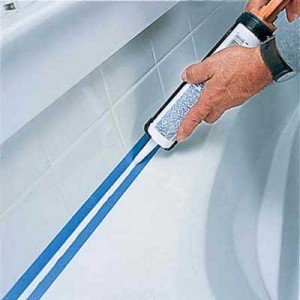Patching and Repairing
November 22, 2011
Filed under Blog
Choosing the Right Seal for Your Project

Once the climate drives us indoors, don’t we tend to notice things that need attention and some degree of repair? Those nail holes, for instance, that haven’t been filled since you moved your artwork around on your walls? Okay, it’s true, the seal above is not the one you’ll need…but he was too cute to ignore! Instead, here are some tips on which products to choose for your sealing and patching projects:
Caulking comes in several different materials and has many uses. Its purpose is to seal surfaces together to keep them non-porous, watertight or airtight. You will need a caulking gun to apply the following caulking materials:
- Silicone Sealant: This is a rubber-like material that seals two surfacestogether. It is effective at keeping moisture in or out, mostly used in bathrooms and kitchens, around sinks, f
 aucets, tubs and toilets. Depending on the brand, it may come in multiple colors. Most 100% silicone sealants are not paintable, but check the specs on the packaging. Good for both indoor and outdoor projects. You can also find an aquarium silicone sealant.
aucets, tubs and toilets. Depending on the brand, it may come in multiple colors. Most 100% silicone sealants are not paintable, but check the specs on the packaging. Good for both indoor and outdoor projects. You can also find an aquarium silicone sealant. - Painter’s Caulk: This is a paintable acrylic latex caulking material that is good for sealing baseboards, trim work around doors and windows, crown molding, counters and siding, to name a few. It is also good for filling nail holes in drywall if you don’t have spackling paste. It dries rapidly and can typically be painted within 30 minutes. Good for both indoor and outdoor projects.
- Siliconized Caulk: This is basically siliconized painter’s caulk (acrylic latex). It is great as a general use caulk, comes in a few (though limited) colors, is easy to use, and some brands are paintable. If you want to use it around sinks and faucets, make sure to buy one with an antimicrobial additive, to slow the growth of mold and mildew.
There are a couple of other products you will find useful as well:
Siliconized Grout: This is an effective sealant to apply along the perimeter of tiled rooms, where the baseboards meet the tiled floors. It comes as a sanded or unsanded product, and most varieties can be color-matched to your grout color. This sealant will appear as grout, but because of the silicone, it will protect against moisture, draft and rot, and last much longer.
 Spackling Paste: Made of gypsum powder and glue to make a paste, most of us know it by the brand name Spackle®. It is perfect for filling holes, and repairing walls and ceilings. This paste comes in light, intermediate and heavy weight mixtures, as well as differing levels of “performance,” depending upon intended use. Small holes need only a lightweight paste, while larger holes require a heavier paste. Most of us keep a small container of spackling paste handy. In a pinch, believe it or not, you can use a dab of toothpaste to fill holes as well.
Spackling Paste: Made of gypsum powder and glue to make a paste, most of us know it by the brand name Spackle®. It is perfect for filling holes, and repairing walls and ceilings. This paste comes in light, intermediate and heavy weight mixtures, as well as differing levels of “performance,” depending upon intended use. Small holes need only a lightweight paste, while larger holes require a heavier paste. Most of us keep a small container of spackling paste handy. In a pinch, believe it or not, you can use a dab of toothpaste to fill holes as well.
Construction Adhesive: While caulking has some adhesive properties, it’s not the best choice for an adhesive. A general construction adhesive is best for providing extra holding power, such as Liquid Nailz or Locktite Powergrab. The term “glue it and screw it” refers to gluing wood together before you put nails or screws in it. If the nails or screws become loose over time, the glue holds it together. This is the same adhesive that was used to secure your countertops to your cabinets. Do you have a loose drawer front in your kitchen or bath? Is your doggie door loose in the wall? If you have anything loose or broken that needs a strong adhesive, this is it.
With time off during the holidays, you might want to tackle a few projects. We hope you’ll find this list helpful for your patching, sealing and repairing issues. If you need any help in this area, don’t hesitate to call on The Fix-It Professionals.
